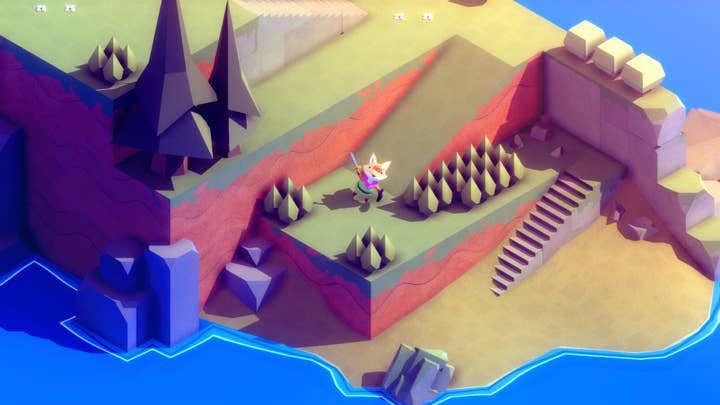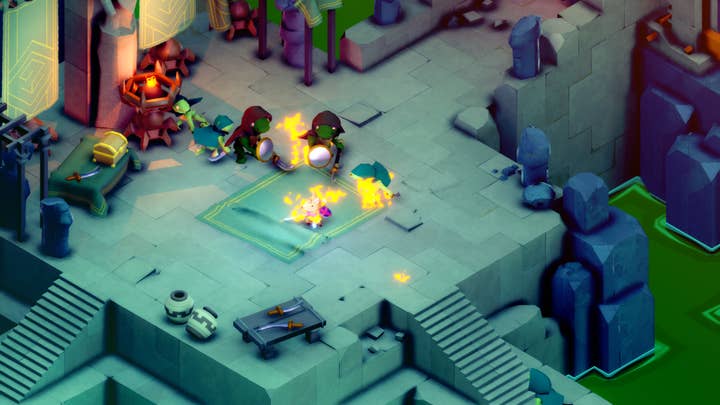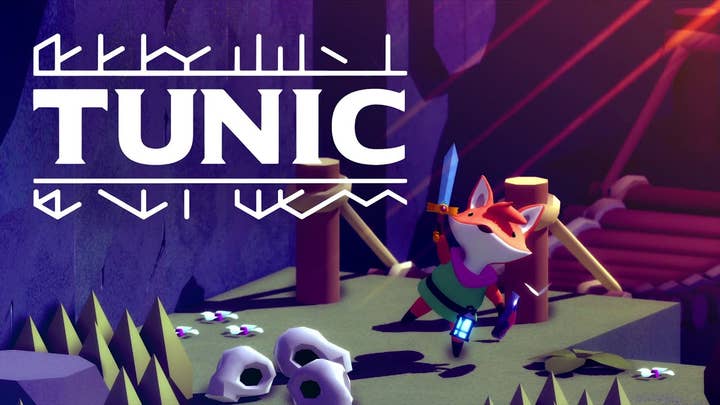Fine-tuning Tunic's marketing message
Finji CEO Bekah Saltsman identified three problems heading into the game's release and five efforts to address them
Tunic was announced to the world with a splash at Microsoft's E3 2018 press conference. And while it gave the game an enviably high profile right off the bat, it also set expectations and created some challenges for the game's publisher, Finji.
In a presentation at Megamigs last week, Finji co-founder and CEO Bekah Saltsman went into detail about how the publisher spent the last 19 months up to the game's release trying to manage expectations and communicate to prospective customers just what sort of experience they were in for.
"People filled in all the stuff we didn't say about Tunic with their own ideas..."
"Tunic an isometric action adventure where you play a tiny fox in a big world and explore the wilderness, fight monsters, and discover secrets," Saltsman said, encapsulating the basic pitch of the game. "And that's all we ever told you, you're welcome. And all of those are true statements about the game. However, people filled in all the stuff we didn't say about Tunic with their own ideas, and as the internet is wont to do, not entirely based on anything we said."
She said developers can find these sorts of problems all over the place: in the way people talk about the game on an official Discord server, in phrases that repeatedly pop up across game journalists' write-ups, and in forum threads packed with speculation that turns into a focus of the community.
While developers and publishers may not be able to purge the internet of falsehoods or erroneous assumptions, Saltsman said they are far from helpless to impact what's being said about their games.
"You need to think critically about how others talk about your project," she said. "You need to think critically about how you talk about and present your project, because you can use that information to control the way others talk about your project going forward. So what do you say, what do other people say about your project, and then how can you use that to make sure they're saying true stuff? Because you are responsible for controlling the message of how your game is received at launch."
Since it's impossible to go back and change old messaging or undo a first impression, Saltsman said the point is to sharpen and narrow the earlier, broader messages about a game until you zero in on exactly what it is and build toward a call to action for people to buy the game. And to do that, it's important that the marketing and development sides of the game are on the same page.
"Marketing in games is game design. They are linked together"
"You are building a multi-faceted approach to seed or plant the right talking points and a common understanding of your game in the masses," Saltsman said. "And you're doing this through assets you're developing internally. Marketing in games is game design. They are linked together. You don't make a marketing demo without a game designer at the helm of it. You work together."
In evaluating perceptions around Tunic a couple years before its launch, Saltsman and Finji identified three potentially big problems that they would want to smooth out before the game went on sale.

The problems
Problem 1: The myth of the solo developer
This is one lots of indie games deal with, but it probably didn't help with Tunic that Xbox head Phil Spencer followed up the E3 trailer debut by describing it to the crowd as "a labor of love conceived and created by a single developer in Halifax, Nova Scotia…"
While the "solo" developer Spencer spoke of, Andrew Shouldice, handled core duties for art, animation, design, programming and other elements of the game, Saltsman said about 50 people wound working on it before it was shipped, including significant contributions of music, art, programming, production, QA, design, engineering, and so on.
"This is the easiest problem to fix," Saltsman said, "because all you do is put up a website with many people on it, and when you do interviews, you talk about the other people who worked on the game. If you think you're a solo developer and you work with people, when you go into an interview where you might be the most well-known person there, please for the love of all things holy talk about the other people on your project."
The remaining two problems would prove trickier, and Saltsman saved her solutions until after as they were in some cases applicable to both issues.

Problem 2: Zelda to Dark Souls
For many watching the game's E3 trailer announcement, Tunic called to mind Zelda, which was great because lots of people love Zelda and got excited for it, but less great because the game's combat was of the deliberately challenging Souls-like variety.
"We had Zelda fans on board with our early marketing materials, with super-loud fan groups all over the place," Saltsman said. "And it showed us we had a mismatch between the moment-to-moment gameplay of Tunic that we knew and what they thought the moment-to-moment gameplay was actually going to be."
The worry was that people who wanted a Zelda adventure, or perhaps a cozy friendly game with a happy cute fox as the star, would try the game upon release and find it too brutally unforgiving for their tastes.
They had to refine the marketing message and materials from that point to cue people in to what the game actually was, and what it wasn't.

Problem 3: Secrets
Another inspiration they wanted to get across a bit more was Fez.
Tunic is a game about secrets, and the joy of discovering them. The first two hours of play are key, Saltsman said, because it doesn't do much hand-holding, and there's no tutorial by design. As the fox, the player wakes up on a strange island and doesn't know where they are or what they need to do. Figuring that out is the game.
"It is not at all remotely acceptable to launch a game that way, especially in modern day gaming," Saltsman said. "We want the player to feel some confusion as they're getting their bearings early on. The player is going to feel this because they're not asking the right questions. In those early moments of the game, Tunic is trying to teach the player to ask the right questions for the game."
"In those early moments of the game, Tunic is trying to teach the player to ask the right questions for the game"
It's a hard marketing problem, Saltsman said, when you can't talk about the secrets without giving away their existence. Another problem with the secrets is that they were intended to be discovered through community collaboration, but the first wave of people who were going to get hands on with the game were the press, who would not have the benefit of masses of people in online communities collectively solving and documenting each stumbling block they may run into.
"I'm sorry, I love you all press, but you want to know who's picky and not very nice and doesn't have a lot of time and too many games to play, especially [leading up to the game's launch] in February and March? It's the press," Saltsman said. "And if I gave them a reason to bounce out of the game, my reviews were going to be terrible on a seven-year project that's super-hyped that needs to be able to fund people to make more games."
Finji's answers to these problems were the result of a re-evaluation of its marketing message, and were all enacted in the final 19 months prior to launch.
The solutions
Solution 1: The combat demo
One of the big parts of the answer was a new demo for the game. Finji had been showing the game's original demo at various events for years, but it "wasn't telling people what Tunic was all about," Saltsman said, so they made a second demo specifically to get across how the game's combat worked.
"The thought process behind designing it was to get across that combat was harder than you think and you're going to die a lot," Saltsman said.
It wasn't a complete abandonment of the original demo and marketing's Zelda-esque appeal. Saltsman said they made sure to include a variety of new environments in the demo – caves, sewers, and so on – that scratched the exploration itch of Nintendo's franchise, and they also sprinkled in a variety of secrets for the community to find and talk about, things that could be missed on playthroughs so players had a reason to compare notes.
Solution 2: Media exposure
IGN reached out to preview Tunic heading into the game's launch, and Saltsman said they turned it into an exclusive and gave the outlet access to the entire development team in order to help address the "solo developer" misconceptions.
Saltsman acknowledged not every developer is going to have IGN reaching out to them, but emphasized, "Any media exclusive actually is useful, or finding the one journalist who is like, 'I have to have your game.' Because they're going to be the one who understands it the most and they're going to be able to seed talking points out into the public… The journalist or streamer or content creator is going to talk about your asset in your terms without you telling them this information, if you designed it right."
For example, with the combat demo, Saltsman said they intentionally bludgeoned players with the difficulty to make it abundantly clear they were going for a Souls-like feel.
"You're giving them an example of what they should be talking about without ever having to say the words to them"
"No one could miss it," she said. "Everyone talked about it that way. So you're giving them an example of what they should be talking about without ever having to say the words to them. You're preparing your assets to help them tell your story, the story you need to tell."
They also made sure to get as much press mileage out of that demo as possible. They debuted it on Xbox in June and released the same demo on Steam in the fall, because they wanted to make sure people were still talking about it and it was still fresh in memory when they announced a release date trailer in December.
"Use an expensive asset everywhere," Saltsman said. "Every pair of eyeballs – especially if you're indie – is a brand new pair of eyeballs, you just need to collect them up. ---especially if they are corrective assets"
Solution 3: The release date trailer
That release date trailer would debut in December at The Game Awards, something Saltsman said took a lot of negotiation, but was a natural choice considering how much overlap that audience had with Xbox players. And much like the IGN exclusive, Saltsman stressed that developers don't need as big a platform as The Game Awards, so much as they need to find one that speaks to their audience.
"Come up with your top tier and then ten back-up plans for it because that's the way video games works," Saltsman said. "But [think about] who's your audience? Get it in front of them. Who needs that corrective message the most?"
Obviously, the trailer itself reflected that corrective message. It opens with another cute glimpse of the fox protagonist that is quickly cut short by a screaming enemy called a siege engine.
"You're bringing in the familiar, filling the blanks you created… And you're changing the launch tone," Saltsman said, referring to early speculation that Tunic might belong in the wholesome or cozy subcategory of games.
"Everyone is like, 'It's comfortable, this is going to be great'," Saltsman said. "And no, you're going to die a lot and also things scream at you and at the end of it there's like, crucified foxes hanging off of stuff and they're emaciated. And that's in Tunic but you don't know that, so we are going to tell you."
Solution 4: Full-court press on the press
In the last three months leading up to launch, Finji turned its attention to press and PR initiatives.
"You have to make time for this even if it means bringing on somebody else to make time for it," Saltsman said. "Because this is the person who's going to talk to the press, get the keys to the press, and possibly pitch stories to the press that aren't just reviewing the game.
"You have to talk about you, and why you made stuff, because that is part of controlling the message"
Reviews are important, she said, but they aren't the be all, end all of game coverage, and they're not articles about the team that made the game.
"You have to talk about you, and why you made stuff, because that is part of controlling the message," Saltsman said. "Otherwise people are going to fill in the blanks if you don't tell them stuff."
For Tunic, they pitched retrogaming nostalgia angles, team calls about level design, the background story of making the game, and combat in Souls-like games.
"We launched alongside Elden Ring, which could have been really bad," Saltsman said, "but we played it through pitching stories intentionally to make sure they were part of the conversation and not antagonistic to the conversation."
She cautioned that developers need to be careful with these angles to ensure they're still homing in on the proper perception of the game being made. For example, she said the team was "obsessive" about making sure whey they referenced homages and callbacks to retro inspirations, that those came directly alongside assurances that the game embraced modern gameplay and features.
"We didn't want to be pigeon-holed into being retro only, or slavishly retro," she said. "That would do a disservice to the game because Tunic is a modern take on a classic genre."
Solution 5: The press kit and media Discord server
Finally, there was the issue of how they could give the press something approximating the Tunic experience of community discovery and problem solving.
One part of that came in the press kit. Each kit sent out had a single puzzle piece in it, and they encouraged the press to talk with each together to solve the puzzle. When they did, they received a code for a big head mode cheat in the game. The whole idea was training them to think of the collaborative element of the game, while also seeding them with the idea that the game contains lots of secrets.
The second part was bigger, as Finji set up a Discord server specifically for 500 members of the press. It was gated behind spoiler secret channels and Finji was almost entirely hands off in running it. The marketing team had access to make sure nobody was breaking rules (no datamining, no being abusive, no spoiling things for others) and they had a QA person in there to address bugs. The rest of the developers weren't allowed in there, and they provided no gameplay help.
"What ended up happening is they started making their own community, which was incredible because they were playing the game together," Saltsman said. "They didn't talk about their opinions on the game, but they talked about how to solve the puzzles in the game, where to go next, what does that item do? And people were giving hints in the coolest ways, and I was like, 'Oh my god, it's actually working. This is how our community post-launch is actually going to respond to the game'."
"We gave them a way to talk about secrets inside all of their reviews because they solved the secrets, and they desperately wanted everyone else to also solve [them]"
It didn't just help the press approximate what it would be like for their readers to play the game. It also helped create something akin to a fear of missing out. And the way the press described the secrets – carefully doing their best not to spoil them in the process – helped create a template for players to do the same thing.
"We gave them a way to talk about secrets inside all of their reviews because they solved the secrets, did it with a community, and they desperately, desperately wanted everyone else to also solve those secrets," Saltsman said.
All of the above took 19 months, but Tunic launched on Xbox and PC with an 85 Metacritic review average that grew to 88 when it arrived on Switch and PS5. Saltsman says the re-evaluation that took place was crucial in helping ensure people knew what to expect heading into Tunic.
"This is a constant process," Saltsman said. "When you re-evaluate and understand what people are saying about your game, you're constantly working towards ensuring that the people who play your game at launch are using the words you want them to use.
"And I'm not being manipulative with this. The way you talk about it and the things you make are all telling the story you want to tell. None of this should be happenstance."
More GamesIndustry.biz Academy guides to Selling Games
Our guides to making money from video games cover various aspects of the publishing process, whether you're a young game developer or an industry veteran:


